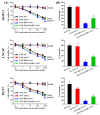Sterically Stabilized RIPL Peptide-Conjugated Nanostructured Lipid Carriers: Characterization, Cellular Uptake, Cytotoxicity, and Biodistribution
- PMID: 30360549
- PMCID: PMC6321264
- DOI: 10.3390/pharmaceutics10040199
Sterically Stabilized RIPL Peptide-Conjugated Nanostructured Lipid Carriers: Characterization, Cellular Uptake, Cytotoxicity, and Biodistribution
Abstract
As a platform for hepsin-specific drug delivery, we previously prepared IPLVVPLRRRRRRRRC peptide (RIPL)-conjugated nanostructured lipid carriers (RIPL-NLCs) composed of Labrafil® M 1944 CS (liquid oil) and Precirol® ATO 5 (solid lipid). In this study, to prevent the recognition by the mononuclear phagocyte system, polyethylene glycol (PEG)-modified RIPL-NLCs (PEG-RIPL-NLCs) were prepared using PEG3000 at different grafting ratios (1, 5, and 10 mole %). All prepared NLCs showed a homogeneous dispersion (130⁻280 nm), with zeta potentials varying from -18 to 10 mV. Docetaxel (DTX) was successfully encapsulated in NLCs: encapsulation efficiency (93⁻95%); drug-loading capacity (102⁻109 µg/mg). PEG-RIPL-NLCs with a grafting ratio of 5% PEG or higher showed significantly reduced protein adsorption and macrophage phagocytosis. The uptake of PEG(5%)-RIPL-NLCs by cancer cell lines was somewhat lower than that of RIPL-NLCs because of the PEG-induced steric hindrance; however, the uptake level of PEG-RIPL-NLCs was still greater than that of plain NLCs. In vivo biodistribution was evaluated after tail vein injection of NLCs to normal mice. Compared to RIPL-NLCs, PEG(5%)-RIPL-NLCs showed lower accumulation in the liver, spleen, and lung. In conclusion, we found that PEG(5%)-RIPL-NLCs could be a promising nanocarrier for selective drug targeting with a high payload of poorly water-soluble drugs.
Keywords: RIPL peptide; biodistribution; cellular uptake; cytotoxicity; nanostructured lipid carrier; steric stabilization.
Conflict of interest statement
The authors declare that they have no conflicts of interests.
Figures









Similar articles
-
Enhanced docetaxel delivery using sterically stabilized RIPL peptide-conjugated nanostructured lipid carriers: In vitro and in vivo antitumor efficacy against SKOV3 ovarian cancer cells.Int J Pharm. 2020 Jun 15;583:119393. doi: 10.1016/j.ijpharm.2020.119393. Epub 2020 May 4. Int J Pharm. 2020. PMID: 32376445
-
pH-sensitive PEGylation of RIPL peptide-conjugated nanostructured lipid carriers: design and in vitro evaluation.Int J Nanomedicine. 2018 Oct 23;13:6661-6675. doi: 10.2147/IJN.S184355. eCollection 2018. Int J Nanomedicine. 2018. PMID: 30425481 Free PMC article.
-
RIPL peptide-conjugated nanostructured lipid carriers for enhanced intracellular drug delivery to hepsin-expressing cancer cells.Int J Nanomedicine. 2018 Jun 1;13:3263-3278. doi: 10.2147/IJN.S166021. eCollection 2018. Int J Nanomedicine. 2018. PMID: 29910614 Free PMC article.
-
Surface-Modification of RIPL Peptide-Conjugated Liposomes to Achieve Steric Stabilization and pH Sensitivity.J Nanosci Nanotechnol. 2017 Feb;17(2):1008-17. doi: 10.1166/jnn.2017.12670. J Nanosci Nanotechnol. 2017. PMID: 29671978
-
Docetaxel-loaded RIPL peptide (IPLVVPLRRRRRRRRC)-conjugated liposomes: Drug release, cytotoxicity, and antitumor efficacy.Int J Pharm. 2017 May 15;523(1):229-237. doi: 10.1016/j.ijpharm.2017.03.045. Epub 2017 Mar 21. Int J Pharm. 2017. PMID: 28341149
Cited by
-
Primary Studies on Construction and Evaluation of Ion-Sensitive in situ Gel Loaded with Paeonol-Solid Lipid Nanoparticles for Intranasal Drug Delivery.Int J Nanomedicine. 2020 May 4;15:3137-3160. doi: 10.2147/IJN.S247935. eCollection 2020. Int J Nanomedicine. 2020. PMID: 32440115 Free PMC article.
-
Synergistic approach of PEGylated photothermal agent and immunomodulator in cancer immunotherapy.Nanomedicine (Lond). 2025 May;20(9):967-983. doi: 10.1080/17435889.2025.2489342. Epub 2025 Apr 11. Nanomedicine (Lond). 2025. PMID: 40214079 Review.
-
Characterization of Biological Material Adsorption to the Surface of Nanoparticles without a Prior Separation Step: a Case Study of Glioblastoma-Targeting Peptide and Lipid Nanocapsules.Pharm Res. 2021 Apr;38(4):681-691. doi: 10.1007/s11095-021-03034-8. Epub 2021 Apr 7. Pharm Res. 2021. PMID: 33829340 Free PMC article.
-
Development and Evaluation of Docetaxel-Loaded Nanostructured Lipid Carriers for Skin Cancer Therapy.Pharmaceutics. 2024 Jul 19;16(7):960. doi: 10.3390/pharmaceutics16070960. Pharmaceutics. 2024. PMID: 39065657 Free PMC article.
-
Peptide-Based Bioconjugates and Therapeutics for Targeted Anticancer Therapy.Pharmaceutics. 2022 Jun 29;14(7):1378. doi: 10.3390/pharmaceutics14071378. Pharmaceutics. 2022. PMID: 35890274 Free PMC article. Review.
References
-
- Kang M.H., Park M.J., Yoo H.J., Hyuk K.Y., Lee S.G., Kimm S.R., Yeom D.W., Kang J.K., Choi Y.W. RIPL peptide (IPLVVPLRRRRRRRRC)-conjugated liposomes for enhanced intracellular drug delivery to hepsin-expressing cancer cells. Eur. J. Pharm. Biopharm. 2014;87:489–499. doi: 10.1016/j.ejpb.2014.03.016. - DOI - PubMed
Grants and funding
LinkOut - more resources
Full Text Sources
Research Materials

